Infrared imaging applications: See the heat, feel the light
From changing channels to changing what we see, Infrared lights up our lives
|
“Now the world has gone to bed, (from From Life, the Universe, |
 |
|---|
Seeing is believing, and what we see informs our lives in countless ways. For Marvin, seeing beyond the visible spectrum into the infrared is a sleepless curse. For us mere mortals, seeing more than we can see with our naked eyes is more of a blessing, revealing new details, making sure our food and medicines are safe, guiding our eyes and our technology to places we could never go before. And changing our channels.But what does infrared help us to see? Let’s find out.
The heat is on with infrared
Infrared (IR), or infrared light, is a type of electromagnetic radiation that’s (mostly) invisible to humans but that we can feel as heat. Heat is everywhere, literally: everything in the universe gives off some level of IR, from the obvious examples of the sun and fire to the less obvious heat coming from powders, gases, ice and snow…everything. And by harnessing IR, heat helps us to see – and control – what we otherwise couldn’t.
They’re Caaaaaalorific!
The 19th century astronomer Sir William Herschel is credited with the discovery of infrared light. He discerned that sunlight was made up of all of the colours of the spectrum, and he knew the sun was hot. Herschel wanted to find out which specific colors were responsible for heating objects.
Herschel observed an increase in temperature as he moved a thermometer from violet to red in the rainbow created by sunlight passing through a prism, with the hottest temperature actually beyond (or ‘below’) red light. He was surprised by these invisible rays and called them “Calorific Rays”. Today we call those rays infra (Latin for ‘below’) red. It took another hundred years for us to be able to explain why. With the help of quantum theory, we learned that radiant heat had a wave-shaped distribution, and that as it gets hotter, it shifts in the spectrum toward shorter wavelengths. This is why some objects start to ‘glow’ when they are hot enough.
Infrared regions: Near, far, wherever you are
The IR spectrum is divided into either 4 or 5 regions, and each region has quite different applications. The 4 commonly referenced regions are Near Infrared (NIR) with wavelengths of 750 – 1,000 nm, Short-Wave Infrared (SWIR) at 1 – 3 µm, Medium- or Mid-Wave Infrared (MWIR) at 3 – 5 µm and Long-Wave Infrared (LWIR) clocking in at 8 – 15 µm.
The poor cousin (often left out of the conversation except by purists) is Far Infrared (FIR). Different sources use different boundaries for the far infrared, and some disciplines don’t recognize it at all; for example, astronomers sometimes define far infrared as wavelengths between 25 μm and 350 μm, while others stretch the outer boundary to 1mm. Whatever the case, Far Infrared is the hottest. By far. The shorter NIR waves, which are closer to visible light on the electromagnetic spectrum, emit no detectable heat at all but the longer far infrared waves, closer to the microwave section, can be felt as intense heat, such as the heat from fire. Or your infrared grill.
This illustration shows a few of the more common applications within each region of the IR spectrum. The next few sections look at each of these regions and applications in more detail.
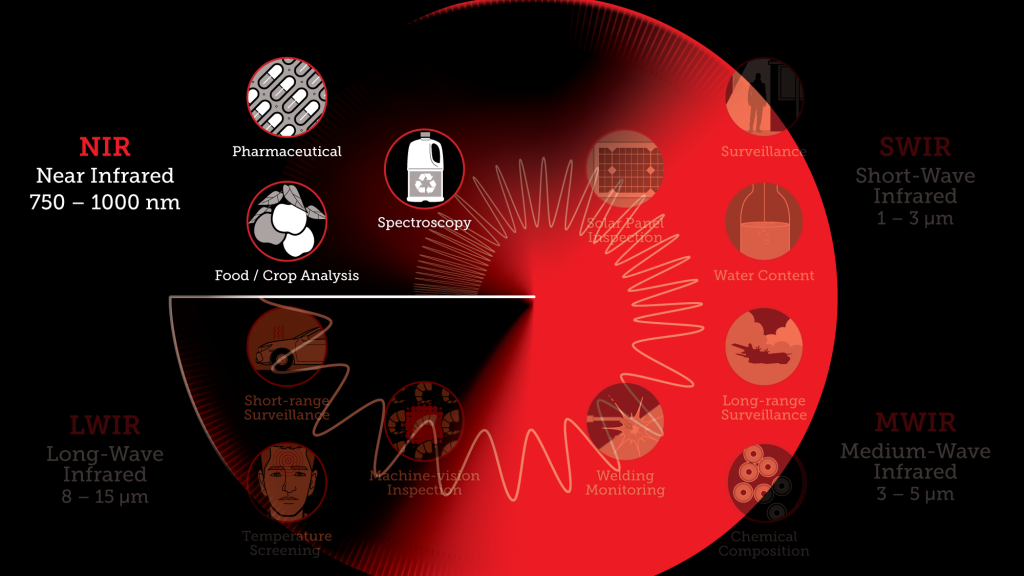
Separating the wheat from the chaff with Near Infrared
Near-infrared spectroscopy (in the range of 750 – 1,000 nm) is based on molecular overtone and combination vibrations. Molecules vibrate, and have related to their fundamental wavelength. Just as we hear a musical note that is a combination of a fundamental note with its overtones, so molecules may vibrate in complex combinations of their fundamental and overtone vibrations.
The molecular absorptivity – that is, how strongly a chemical species attenuates light at a given wavelength – in the NIR region is quite small, which means that NIR can typically penetrate much further into a sample than mid-wave IR (MWIR). That makes it particularly useful for probing bulk material with little or no sample preparation.
NIR sees deeply, from farm to pharma
The first industrial applications for NIR began in the 1950s, as an add-on to other optical devices that used other wavelengths. By the 1980s stand-alone NIRS was focused on chemical analysis, but with the introduction of light-fiber optics in the mid-80s NIRS became a much more powerful scientific research tool.
Today, NIR is used to analyse food products, pharmaceuticals, gas, and the stars.
On the farm: Because it is accurate, reliable, rapid, non-destructive, and inexpensive, NIRS is widely applied in agriculture to quantify the composition and quality of grains, dairy products, eggs, meat, and other agricultural products. Hyperspectral imaging using NIR has been applied for a wide range of uses, including the remote investigation of plants and soils, with data collected from instruments on airplanes or satellites to assess ground cover and soil chemistry.
In the lab: NIR is often used in particle sizing in a range of different fields, including pharmaceuticals and agricultural powders. NIR spectroscopy is also used with microscopic sample areas for film thickness measurements, research into the optical characteristics of nanoparticles and optical coatings for the telecommunications industry.
In space: Astronomical spectrographs using NIR reveal the atmospheres of cool stars (cool as in low temperature, not attitude) and give a clue about the star’s spectral type. NIR is less affected by dust in the interstellar medium (known as reddening), and can see far into the gaseous mysteries, providing important information about their age and mass.
In our bodies: NIR provides information about the oxygen saturation of haemoglobin within microcirculation. Broadly speaking, it can be used to assess oxygenation and microvascular function in the brain (cerebral NIRS) or in the peripheral tissues (peripheral NIS), screening for possible intracranial bleeding and assessment of brain function and providing information about tissue perfusion.

Seeing in the dark with Short-Wave Infrared
Short-wave infrared (SWIR) light is in the range of 1 – 3 µm, or more exactly 1,100 – 3,000 nm. Except for the fact that you can’t see it with the naked eye, SWIR is like visible light in that photons are reflected or absorbed by an object, unlike mid-wave and long-wave infrared light, which is emitted from the object itself.
Many applications that are impossible using visible light are possible using SWIR. When imaging in SWIR, water vapor, fog, and certain materials such as silicon are transparent, and colors that appear almost identical in visible light can be easily differentiated.
I can see clearly now, the rain is gone
Johnny Nash had it right, you can see clearly when the rain is gone, and that’s the big advantage of SWIR cameras: they “see through” and generate higher contrast images in haze, mist, rain, fog and challenging atmospheric conditions. That makes them ideal for many applications, from military (laser guidance systems, camouflage detection, surveillance, night vision, land border monitoring and more) to civil (solar cell inspection, plant inspection, crop monitoring, fire fighting, etc.).
The images above were taken at the same time, at the same magnification, and show the edge of cliffs and a boat in SWIR light (left) and visible light (right). The right image is completely obscured by thick haze, which the SWIR camera sees right through.
What’s that under your coat, sir?
Compare these two images of the same painting (The Last Judgment by Jan Provost, copyright Detroit Institute of Arts), the left imaged with visible light and the right in the SWIR waveband. It could be that Jan realized that ten trumpets were a bit too judgemental, even at the end, and went with just the five. Without SWIR (or Jan’s diary) we would never know that ten was his original idea.

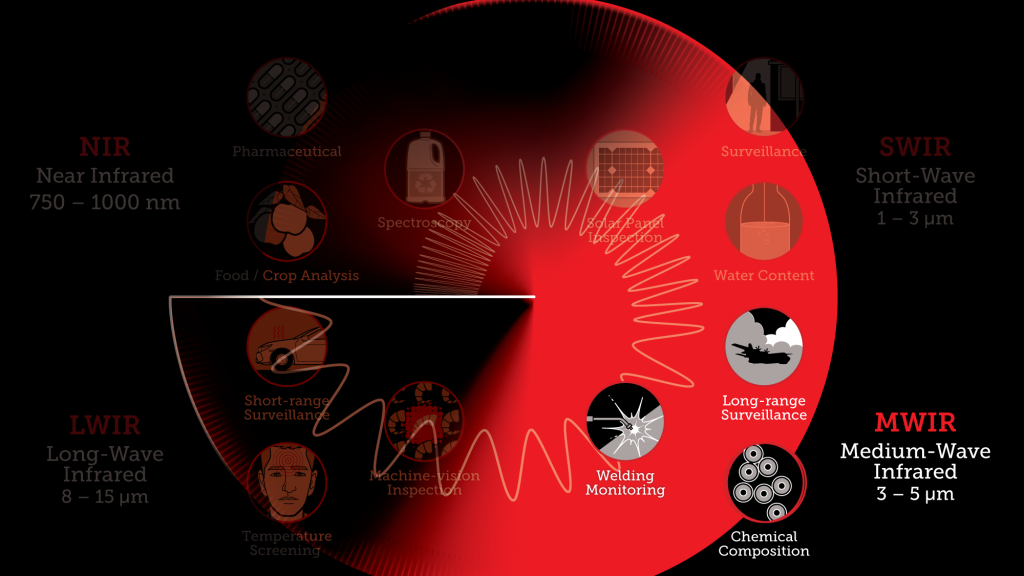
Mid-Wave Infrared finds the target
When we reach mid-wave infrared, at 3 – 5 µm, we’re not using IR to enhance reflected photons anymore. Instead, we’re observing the radiation coming from the object itself. In guided missile technology, this region is the atmospheric window in which the homing heads of passive IR ‘heat seeking’ missiles are designed to work, honing on to the infrared signature of the target aircraft, typically the jet engine exhaust plume. This region is also known as thermal infrared.
While it’s perfect for long-range surveillance of heat-emitting sources, thermal imagery in the mid-wave region can also be used to monitor the temperature of parts during manufacturing, checking electronic components for hot spots (indicative of defects), checking the temperature of perishable goods, and even seeing through some plastics or other materials for packaging checks.

What’s that smell?
Infrared gas detectors work based on the principle of infrared absorption: an IR source illuminates gas in a measurement chamber, which absorbs some of the IR wavelengths while others pass easily through unchanged.
Weld monitoring is another important application of thermal imaging since infrared emissions indicate the heat content of the weld. For example, deeper penetration tends to correlate with increased heat input (caused by higher current or slower weld speed). Greater heat input results in higher temperatures and increased infrared emissions. Heat flow into the material is disturbed by the presence of a subsurface defect, causing a temperature contrast at the surface, which is measured using the thermal imaging equipment as thermograms and analyzed to determine the actual flaw.
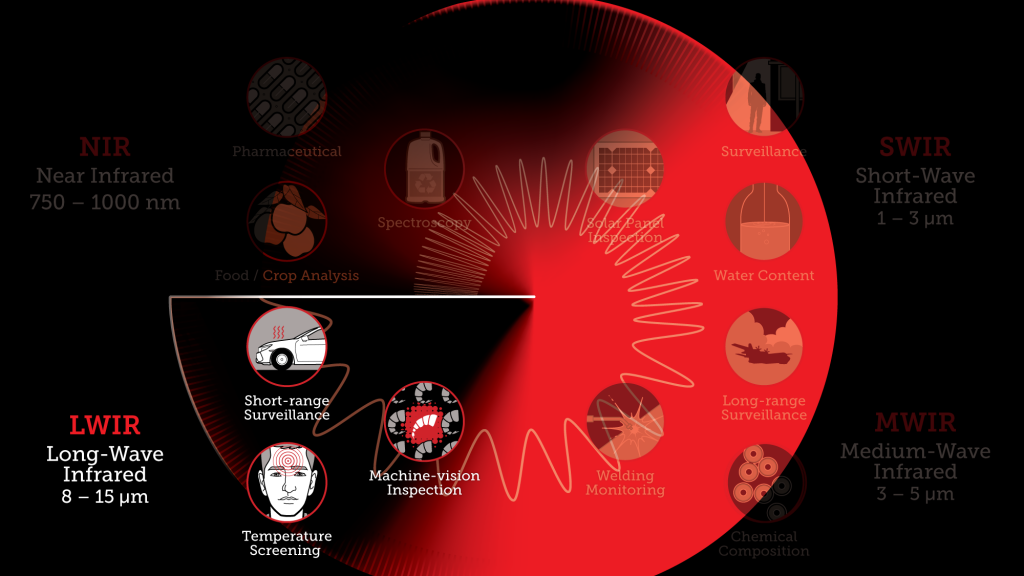
Keeping cool with Long-Wave Infrared
Thermal imaging of objects at or near room temperature is typically done in the 8–15 μm longwave-infrared (LWIR) spectral band, as the Planck curve for blackbody radiation for room-temperature (300 K) objects peaks in the LWIR at about 9 μm. Planck’s Law is actually the foundation of quantum mechanics, and indicates how much power is being emitted at a particular wavelength for a given temperature – in the case of LWIR, it tells us that for capturing images.
LWIR imaging has the great advantage of being able to image objects by their own light and discriminate between objects based on their temperature; in addition, LWIR imaging works well for outdoor use due to the relatively low output power of the Sun at LWIR wavelengths.
Got a fever? Got lost? LWIR can help!
Non-contact temperature screening devices equipped with LWIR sensors quickly measure surface temperature without making contact with a person’s skin. They’re fast and don’t need to be sterilized between each use, making them ideal for mass temperature screening requirements. Hello 2020.
LWIR is also great for search and rescue: drones equipped with IR cameras can easily spot hot-blooded humans roaming through a cool forest, and even find your stranded pet in a smoke-filled home.
Industry uses LWIR as well, as infrared machine vision lighting enables vision systems to recognize objects and their condition under difficult lighting conditions, for example, reflective surfaces that produce high levels of visible-spectrum noise, high or low levels of illumination, or target areas with variable light intensities. As a result, certain defects or flaws can be detected with IR that can’t be seen with visible light.
Keeping hot with Far Infrared
Nestling up close to the microwave band, Far Infrared (FIR) has a wavelength from 15 μm to 1 mm. We experience FIR in our bodies as radiant heat, a light we can’t see but we can feel.
FIR heat penetrates up to 1.5 inches (almost 4 cm) beneath the skin, has been found to stimulate cells and tissue, and is considered a promising treatment method for certain medical conditions.
The Finnish have it right
A traditional sauna uses heat to warm the air, which in turn warms your body. A FIR sauna heats your body directly without warming the air around you. It also produces these results at lower temperatures than does a regular sauna, which makes it accessible to people who can’t tolerate the heat of a conventional sauna.
Several studies have looked at using FIR saunas in the treatment of chronic health problems, such as high blood pressure, congestive heart failure, dementia and Alzheimer’s disease, headache, type 2 diabetes and rheumatoid arthritis, and found some evidence of benefit.
And beyond saunas, biomedical researchers have experimented with the use of FIR-emitting ceramics embedded into various fibers and woven into the fabric of garments. They propose that this ceramic-emitted FIR (cFIR) has the potential to promote cell repair and help with everything from lactation to arthritis relief and even weight loss.
Conclusion
We’re a curious race, and seeing beyond what we can see with our eyes was once only the stuff of dreams.
Thanks to Herschel’s experiment with prisms and sunlight we can see further, deeper, and so much more. We can investigate, detect, guide, and control. We can ensure the quality of our processes and products, keep ourselves safe near and far, and even enjoy some deep-penetrating therapy.



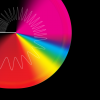 How Deep is your Light? Imaging Across the Spectrum
How Deep is your Light? Imaging Across the Spectrum 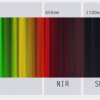 Seeing the unseen: how infrared cameras capture beyond the visible
Seeing the unseen: how infrared cameras capture beyond the visible 